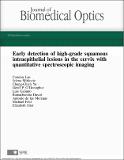Early detection of high-grade squamous intraepithelial lesions in the cervix with quantitative spectroscopic imaging
Author(s)
Lau, Condon; Mirkovic, Jelena; Yu, Chung-Chieh; O'Donoghue, Geoff P.; Galindo, Luis H.; Dasari, Ramachandra Rao; Feld, Michael S.; de las Morenas, Antonio; Stier, Elizabeth; ... Show more Show less
DownloadLau-2013-Early detection of high-grade squamous intraepithelial lesions.pdf (2.665Mb)
PUBLISHER_POLICY
Publisher Policy
Article is made available in accordance with the publisher's policy and may be subject to US copyright law. Please refer to the publisher's site for terms of use.
Terms of use
Metadata
Show full item recordAbstract
Quantitative spectroscopy has recently been extended from a contact-probe to wide-area spectroscopic imaging to enable mapping of optical properties across a wide area of tissue. We train quantitative spectroscopic imaging (QSI) to identify cervical high-grade squamous intraepithelial lesions (HSILs) in 34 subjects undergoing the loop electrosurgical excision procedure (LEEP subjects). QSI’s performance is then prospectively evaluated on the clinically suspicious biopsy sites from 47 subjects undergoing colposcopic-directed biopsy. The results show the per-subject normalized reduced scattering coefficient at 700 nm (A[subscript n]) and the total hemoglobin concentration are significantly different (p<0.05) between HSIL and non-HSIL sites in LEEP subjects. A[subscript n] alone retrospectively distinguishes HSIL from non-HSIL with 89% sensitivity and 83% specificity. It alone applied prospectively on the biopsy sites distinguishes HSIL from non-HSIL with 81% sensitivity and 78% specificity. The findings of this study agree with those of an earlier contact-probe study, validating the robustness of QSI, and specifically A[subscript n], for identifying HSIL. The performance of A[subscript n] suggests an easy to use and an inexpensive to manufacture monochromatic instrument is capable of early cervical cancer detection, which could be used as a screening and diagnostic tool for detecting cervical cancer in low resource countries.
Date issued
2013-07Department
Massachusetts Institute of Technology. Department of Chemistry; Massachusetts Institute of Technology. Spectroscopy LaboratoryJournal
Journal of Biomedical Optics
Publisher
SPIE
Citation
Lau, Condon. “Early detection of high-grade squamous intraepithelial lesions in the cervix with quantitative spectroscopic imaging.” Journal of Biomedical Optics 18, no. 7 (July 1, 2013): 076013. © 2013 Society of Photo-Optical Instrumentation Engineers
Version: Final published version
ISSN
1083-3668
1560-2281